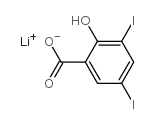| 结构式 | 名称/CAS号 | 全部文献 |
|---|---|---|
 |
3,5-二碘水杨酸锂
CAS:653-14-5 |
|
 |
3,5-二碘水杨酸
CAS:133-91-5 |
| 结构式 | 名称/CAS号 | 全部文献 |
|---|---|---|
 |
3,5-二碘水杨酸锂
CAS:653-14-5 |
|
 |
3,5-二碘水杨酸
CAS:133-91-5 |